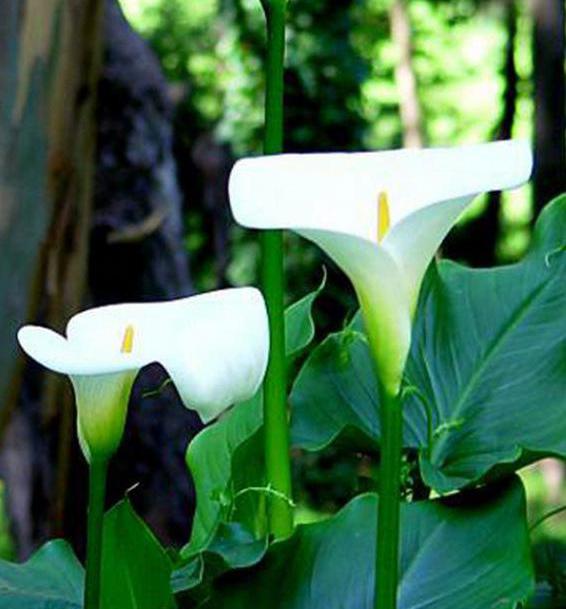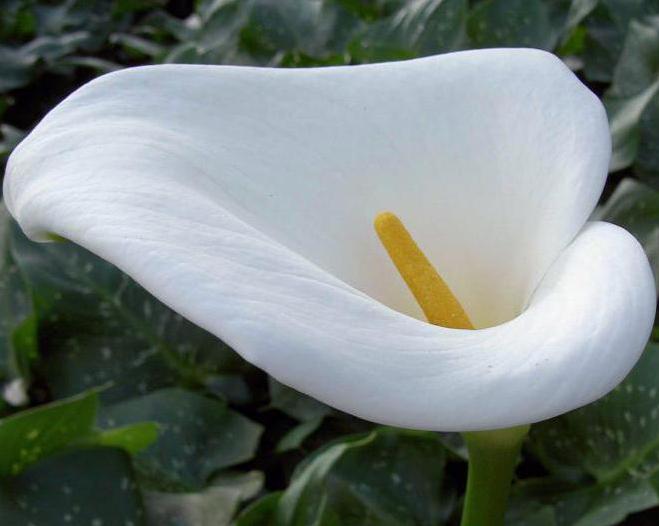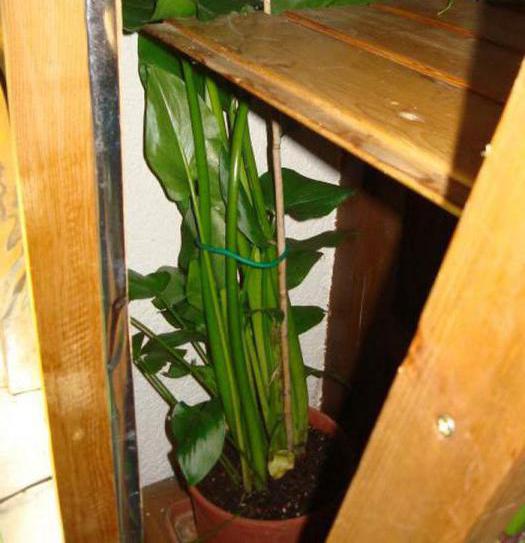Lovers of indoor flowers bigEthiopian calla is popular. The plant of the aroid family is a relative of the marsh calla and calamus. In nature, there are up to 6 different species of it. All of them are very attractive and have unusual qualities.

Description
The homeland of these callas is considered to be South Africa.Gorgeous flowers are a real decoration of apartments, greenhouses, look great in bouquets. The plant is large, with wide, succulent and shiny leaves, heart-shaped and bright green color. They are located on the long basal petioles and collected in the outlet. The original structure is different flower itself. It is formed at the end of the rising arrow and is a yellow inflorescence-the ear, wrapped with a white spathe. Its smell is very weak and reminds vanilla.
Flowering usually begins in the second half.winters and lasts for 1.5–2 months. Under various names, the Ethiopian calla is known - zantedeskia, rishardia, calla. Tuberiform rhizome forms every year numerous offspring that must be removed so that they do not delay flowering.

Growing conditions
Лучше всего каллы чувствуют себя в просторном и bright room. Under conditions as close as possible to natural, the plant will delight with its beauty for a long time. The capacity for these colors is needed volumetric, with a sufficiently deep pallet. Ethiopian calla is not afraid of sunshine, but it must be protected from drafts. It is very important to observe the basic rules of cultivation - maintaining the necessary temperature, lighting, humidity, timely feeding.
Ground Requirements
Under natural conditions, calla lilies preferwetland area. This must be taken into account when preparing the soil mixture for planting, adding river sludge to it and placing a deep pan under the pot (it must contain at least 5 cm of water). If you count on the perennial content of the plant, it is necessary that the substrate be slightly acidic, rich in nutrients. Its composition should contain clay-turf and peat ground, humus, sand (all in the ratio 1: 1: 1: 0.5). Very good, if there is an opportunity to add a little marsh substrate or river sludge. Ethiopian home calla grows well in clean peat. Some growers use manure or compost to make soil mixture.

Landing
In March, prepare spacious pots - for 1 tubercapacity should be at least 3 liters. They sprinkle the soil mixture with the addition of superphosphate (1 tablespoon for every 3 liters of the substrate). The bottom layer must be poured into the drainage layer.
Tubers intended for planting should behealthy. This is evidenced by their elasticity, light yellow color and the presence of living apical buds. Over-dried gray tubers with wrinkled skins are not suitable. Existing areas of rot or growths are carefully scraped with a sharp knife.
Certainpreparatory work. For 2-3 weeks, the tubers shift in a warm place with good lighting. Then immersed for 15 minutes in a weak solution of potassium permanganate, and then dried. This will help protect the flowers from decay and damage by pests that often cause Ethiopian calla.
Planted tubers shallowly - a maximum of 10 cm - and slightly moisturize. Pots are placed where it is warm and there are no drafts.
Watering
In the first 2 weeks in a strong moisture plantdoes not need. Later go to the abundant watering. The water used is soft, settled. During the flowering period, additional moistening is required, so the leaves of the zantedeski are sprayed with a spray bottle and bathed in the shower. It is necessary to ensure that the water was always in the pan.

For a native of tropical Africa, humidity inthe room should be at least 55%. If this condition is observed, the Ethiopian calla will delight not only large flowers, but also beautiful greenery. Caring for a plant involves abundant watering only during the development of leaves and flowering. From the moment when the period of rest comes, they are reduced, then stopped altogether by 1.5–2 months and gradually renewed again. This phase in the development of a plant lasts, as a rule, from autumn to February.
Temperature and lighting
It is advisable that the room for growing callasit was light and airy. Direct sunlight is detrimental to the plant. It is better if the light is a little diffused. A pot with a flower can be placed on the north or east window. An Ethiopian white Calla grows beautifully with artificial light, the main thing is that it is properly selected, otherwise the plant may not bloom. Light day should last 10-12 hours.
An important role is played by the temperature in the room, wheregrowing zantedeskiya. It may fluctuate depending on the phase of development of the calla. During flowering, it is necessary to maintain the temperature in the range of 15–18⁰С. Its increase even by 2 degrees will lead to a decrease in the quality of flowers. During the rest period, it is recommended to clean the callas in a room where from 8 to 10 ° C is heat.
Additional fertilizing
Fertilizers begin to make whenthe first leaflets appear. Combine both root and foliar dressing. Mineral and organic fertilizers are used on average 2 times a month. At the beginning, at the stage of plant development, these are mainly nitrogen fertilizers. During the flowering period, more phosphorus and potassium are needed. You can apply the usual complex fertilizers for indoor plants containing these elements. Longer and more beautiful flowering is more dependent on them. Ethiopian Calla its appearance signals the lack of a nutrient. With a lack of nitrogen leaves fade, losing its gloss. The lack of potassium is expressed in raising up their pointed tips upwards.

Выполняя листовую подкорму очень важно, чтобы droplets of the solution did not fall on the white cover of the flower. This can lead to a loss of its decoration. Periodically replacing the top layer of the substrate, you can do without plant transplantation. At the time when the Ethiopian calla is blooming, home care also permits the introduction of top-dressings in the form of tea leaves, eggshells, fruit peels.
Care of the plant during the rest period
At the end of flowering calla growthsuspended, but the roots continue to develop. This period usually lasts from May to July. Until the autumn, the plant can be placed on a balcony or loggia, where penetrating winds do not penetrate and it is possible to shelter from the sun. Neither watering nor dressing at this time do not.

You can transfer the callas to a state of deep dormancy by completely removing the leaves and placing them in a refrigerator, cellar, or any other place where the temperature is within 3-5 ° C.
Reproduction
It can be produced as offspring, andseeds. The first method is much simpler, therefore, it is often used by flower growers. Scions are called small nodules that form around the ground in large quantities (sometimes there are up to 25 of these). They must be removed in any case in order not to delay the development of the plant. Tubers are separated carefully so as not to damage the roots on them, and they are planted in prepared containers filled with substrate. It is obtained by mixing 2 parts of sod land and one each - peat, leaf and sand. Then the pots are placed in a room with a temperature of + 12-16 ° C and humidity not lower than 80%. Be sure to have good lighting, because otherwise the plants are drawn out, the leaves lose their bright color, and the quality of flowering may later suffer.
To increase the amount of planting materialoffspring can be divided in half so that each has at least one kidney. The fracture site is treated with a weak solution of potassium permanganate or sprinkled with charcoal.
Ethiopian calla propagates with the help of seeds.This method is mainly used by breeders, since it allows preserving the varietal characteristics of the plant. Only fresh seeds are taken for planting. They are soaked for 6 hours in a special solution that stimulates development. After that spread on a damp cloth, covered on top of its other end, and placed for 7 days in a warm place. As soon as the seeds germinate, they are sown in the ground. They are germinated at a temperature of 20 ° C. The appeared entrances dive in separate tanks.

Diseases and pests
Mostly fungal and infectiousEthiopian calla suffers from diseases. Planting and care, carried out without complying with the rules of agricultural engineering, are the main reasons for their occurrence. Waterlogging of the soil, an excess of nitrogenous fertilizers usually lead to the defeat of the plant by a fungus. At the first sign of this, it is necessary to stop watering, replace the soil and process the flower with fungicides.
The most important thing to prevent these diseasesbecause getting rid of some of them can be very difficult. Prevention consists in disinfecting the tubers, removing parts of the plant with the slightest signs of disease.
Of insect pests for callah mostthe danger is a spider mite and aphid. To combat them, it is recommended to spray the plant with special preparations (Fitoverm, Vertimek) and soapy water.
With proper care, this house decorationcan become an Ethiopian calla. Photos of these amazing colors confirm the fact that, with very little effort, you can grow such beauty in your home.












